Physical Address
304 North Cardinal St.
Dorchester Center, MA 02124
Physical Address
304 North Cardinal St.
Dorchester Center, MA 02124
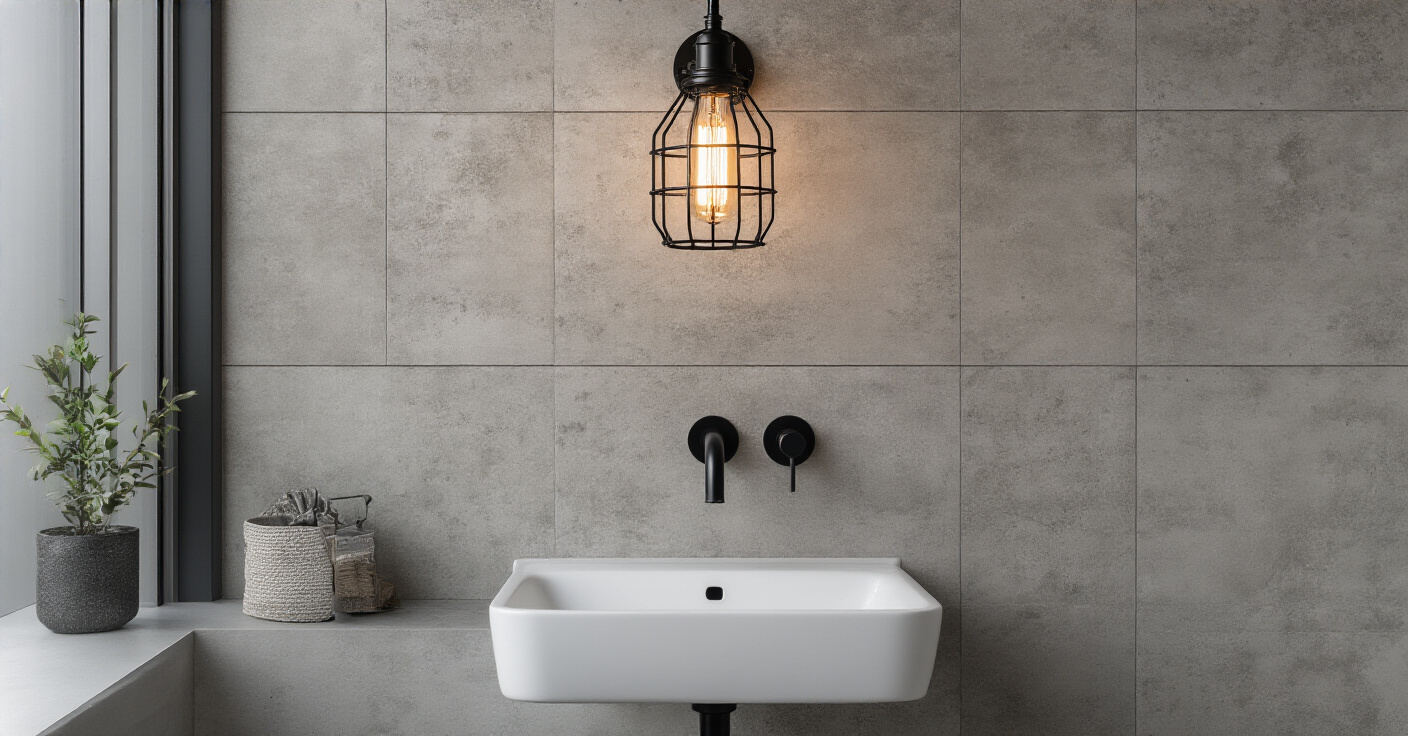
Discover 23 essential industrial bathroom tile ideas that blend raw urban style with warm, inviting charm. Get tips on concrete, metal, and subway tiles for a chic and livable space.
Can we talk about why everyone gets industrial design wrong? Honestly, it drives me a little mad. People see these photos of cold, grey bathrooms that look like abandoned warehouses and think, “Yes, that’s it!” But they’re missing the entire point. True industrial design, like the beautiful old workshops I’ve seen in Milan or the converted lofts in Barcelona, has a soul. It’s about honesty in materials, celebrating the story of a space, and finding beauty in function. It’s not about creating a sterile box.
A friend of mine was just telling me she loves the industrial idea but is terrified her bathroom will end up feeling cold and uninviting. She asked, “Diana, how do I do this without making it feel… well, like a factory?” And that’s the real question, isn’t it? It’s not about copying a look; it’s about capturing a feeling. The secret isn’t just about exposed pipes and concrete. It’s about layering textures, embracing imperfections, and choosing tiles that tell a story of strength and warmth. I used to think this style was so far from my sun-drenched Mediterranean aesthetic, but I’ve realized they share a deep love for authentic, hard-working materials that get better with age.
So, forget the noise you see online. I’m going to tell you what actually matters. Here are the ideas that bridge the gap between that raw, urban look and a space that feels like a warm, welcoming sanctuary.
Before you fall in love with a single tile, we need to talk about the vision. This is the part everyone rushes through, but it’s everything. This isn’t about just picking out pretty things; it’s about authoring the story of your bathroom. Think of it as laying the foundation for a beautiful old villa—get this part wrong, and the whole thing crumbles.
Okay, first things first. “Industrial” is not one-size-fits-all. When you tell me “industrial,” I need to know if you’re picturing a sleek, modern loft in SoHo, a rustic workshop filled with reclaimed wood, or something a bit more wild and imaginative. Are you a minimalist who wants clean lines and polished concrete? That’s ‘Modern Industrial.’ Do you love the idea of aged wood and warm metals next to exposed brick? That’s your ‘Rustic Industrial’ soul speaking.
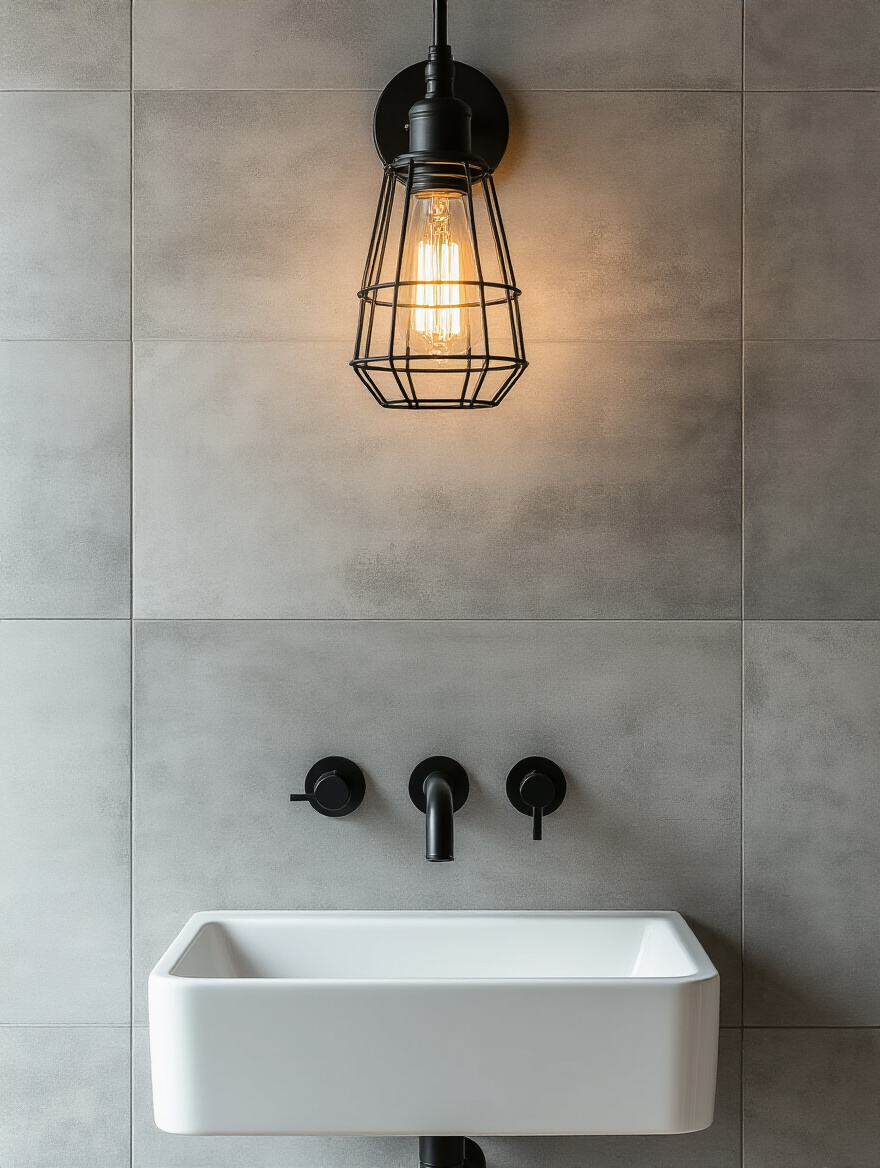
Don’t just scroll on Pinterest and save everything. Take a moment and really think about the feeling. Do you want the space to feel calm and expansive, or cozy and full of character? This one decision will guide every other choice, from the texture of your tiles to the finish on your faucets. I had a client once who couldn’t decide, and her bathroom ended up looking like three different ideas got into a fight. A little clarity now saves a lot of heartbreak later.
Once you have a sense of the mood you’re after, choosing the tile becomes so much easier. You’ll know instantly whether that distressed, metallic tile is right or if you need something cleaner and more monolithic. This isn’t just decorating; it’s about creating a coherent narrative for your space.
This initial choice of aesthetic naturally leads us to the next critical question: how do the tiles you choose relate to the actual size and shape of your room?
You know how people always ask me how to make a small space feel bigger? It’s almost always about tile size. For an industrial look, large format tiles are your best friend. Think big—24×24 inches, or even larger rectangular planks. Why? Because the fewer grout lines you have, the more seamless and expansive the space feels. It tricks the eye into seeing one continuous, flowing surface, much like a poured concrete floor in an old studio.
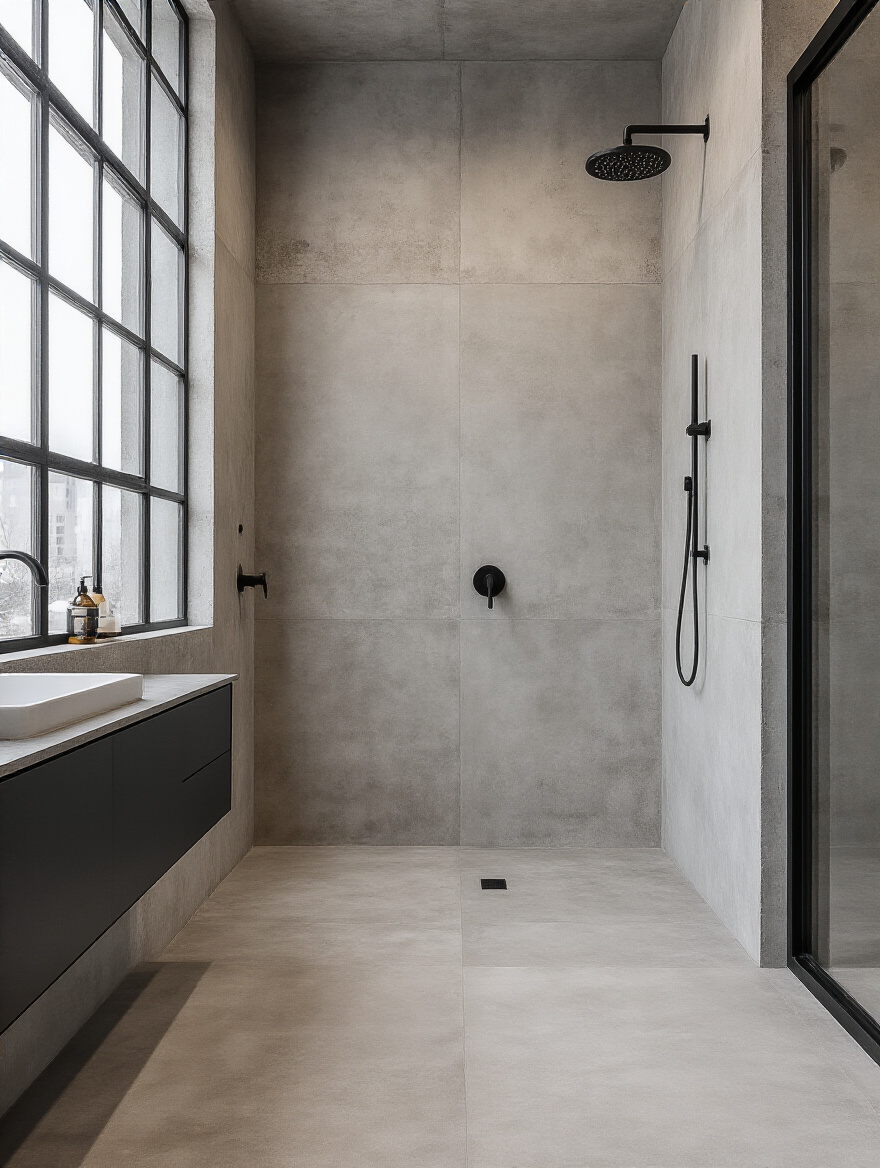
This isn’t just a trick for small bathrooms, though. Even in a large space, big tiles create a sense of calm and grandeur. They feel substantial and intentional, which is the very essence of industrial style. It’s about honesty and simplicity. Small, busy tiles can clutter the look and fight with the raw elements you want to showcase. You want your tile to be the strong, silent backdrop, not the star shouting for attention. Just be sure to hire a fantastic installer—laying large tiles perfectly is an art form.
Remember the story of that old Italian nonna I told you about, the one who said every material should have room to breathe? That’s what this is about. You’re letting the material itself, in its beautiful, simple form, define the space.
Now that we’ve considered scale, let’s talk about something that isn’t as glamorous but is absolutely non-negotiable in a bathroom: durability.
I’ll be honest with you. This is the least sexy part of design, but it’s the one that will save you the most money and sanity in the long run. A bathroom is a battlefield of water, steam, and soap scum. Choosing a tile based on looks alone is a recipe for disaster. This is especially true for an industrial aesthetic, which is supposed to look like it can withstand anything. So, your tiles actually have to be able to withstand anything.
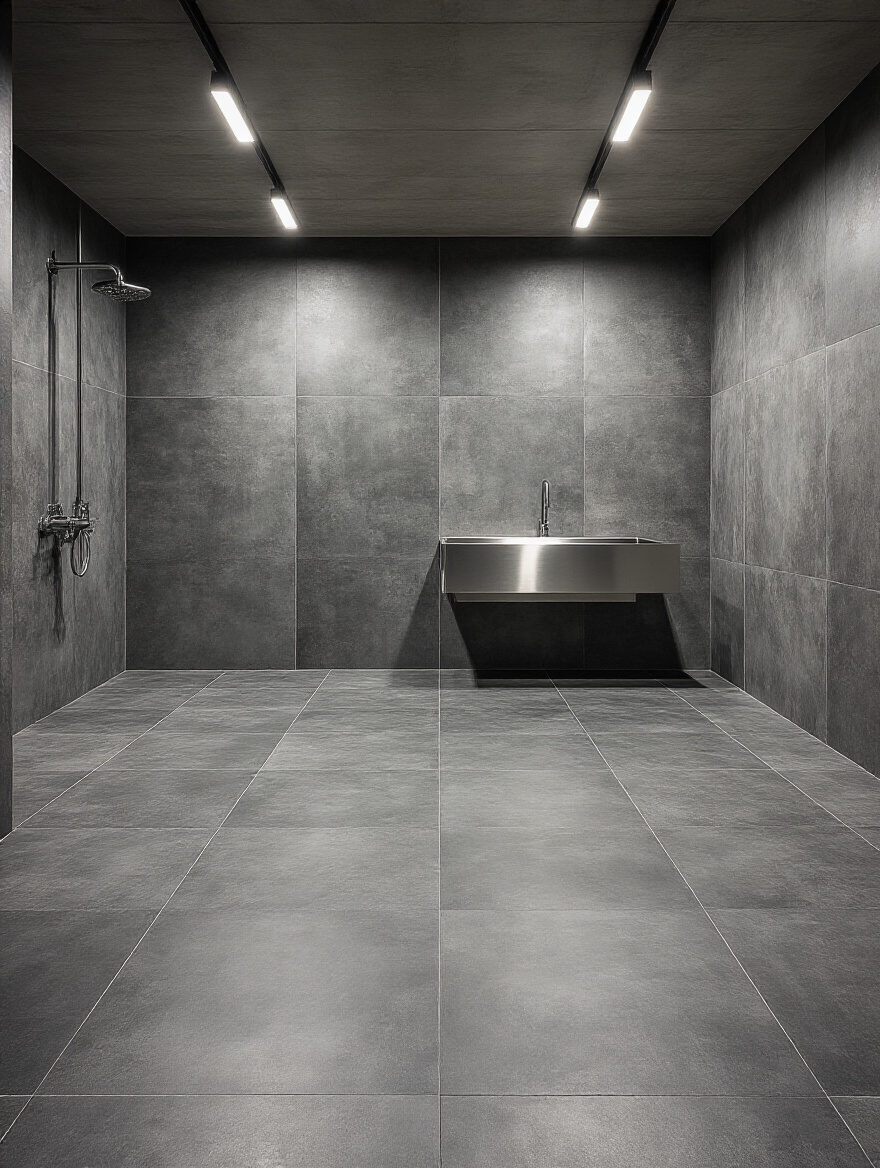
Porcelain is king here. It’s incredibly dense and absorbs almost no water, so you don’t have to worry about it staining or warping. For floors, look for a tile with a good slip-resistance rating—no one wants their chic urban bathroom to become an ice rink. And please, invest in a quality waterproofing system underneath the tile. I know it’s the hidden part no one sees, but a proper waterproof membrane and a strong grout, like an epoxy, is the difference between a bathroom that lasts five years and one that lasts fifty.
Think of it like building a stone wall in an old garden. The foundation you can’t see is more important than the beautiful stones everyone admires. Get the bones right, and the beauty will last.
With the practicalities handled, we can move on to the heart of the design: establishing the perfect, authentic color story for your space.
When we think of industrial, we immediately think of grey. And yes, shades of grey are the backbone of this look, from soft cement to deep charcoal. But a truly beautiful industrial space isn’t just a sea of grey. It’s a carefully layered palette that feels rich and sophisticated. Think about the colors of a blacksmith’s workshop: the black of soot, the white of hot ash, the grey of steel, and the warm, earthy tones of the wooden handles on the tools.
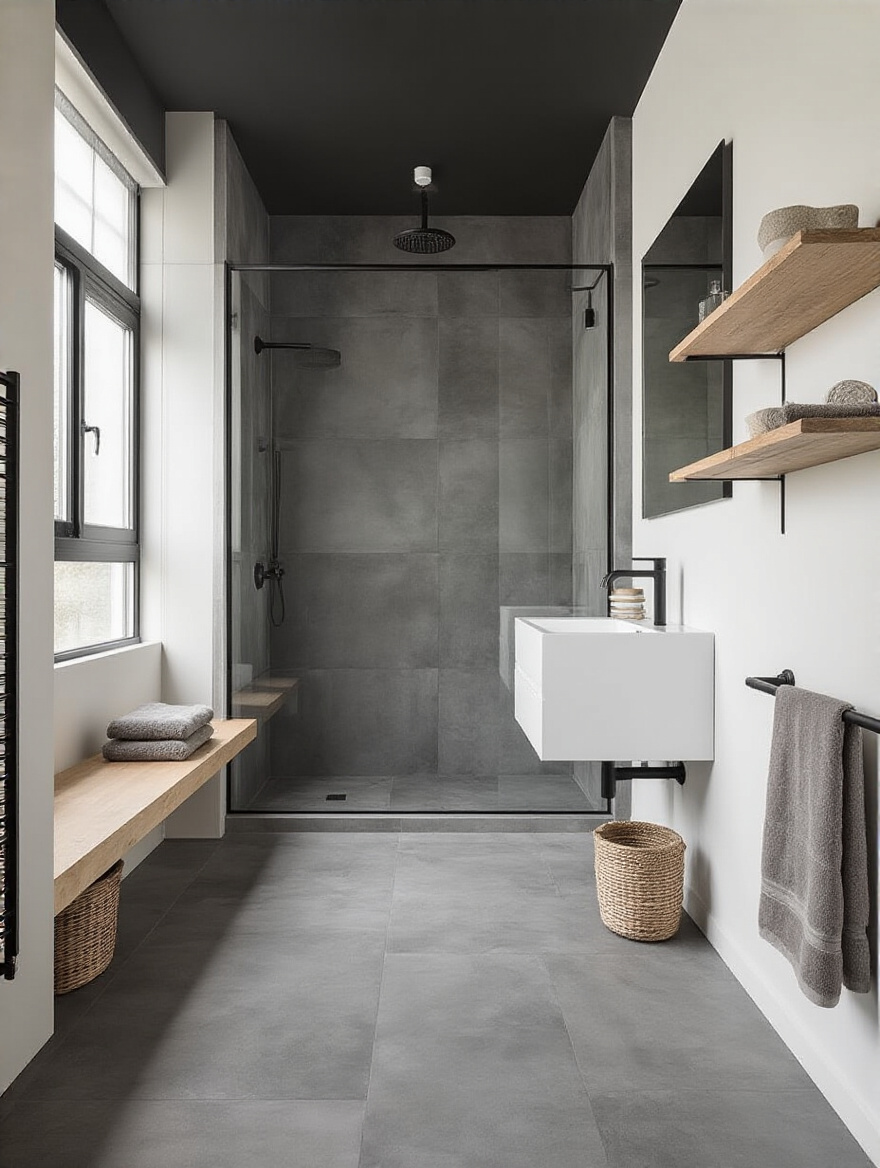
Start with your dominant neutral—maybe a beautiful concrete-look tile. Then, bring in black as an accent. A matte black hex tile on the shower floor or black fixtures can ground the space and give it a graphic punch. Then, you need warmth. This is the secret everyone misses! A touch of wood-look tile, a worn leather stool, or even some olive-green towels can keep the space from feeling sterile. It’s that hint of organic life that makes it feel human.
This palette allows the textures to do the talking. The roughness of the concrete, the smoothness of the metal, the grain of the wood—they all get to shine because the colors are playing a supporting role. That, my friend, is the essence of quiet confidence in design.
We’ve got the emotional and aesthetic foundation down. Now for the nuts and bolts—the things that ensure your beautiful vision can actually come to life without causing a massive headache or emptying your bank account.
Let’s have a frank talk about money. The biggest mistake people make is falling in love with an expensive tile and then trying to save money by hiring a cheap installer. Please, please do not do this. Your installer is even more important than the tile itself, especially with the large formats and precise patterns common in industrial design. A bad installation will make even the most luxurious tile look terrible.
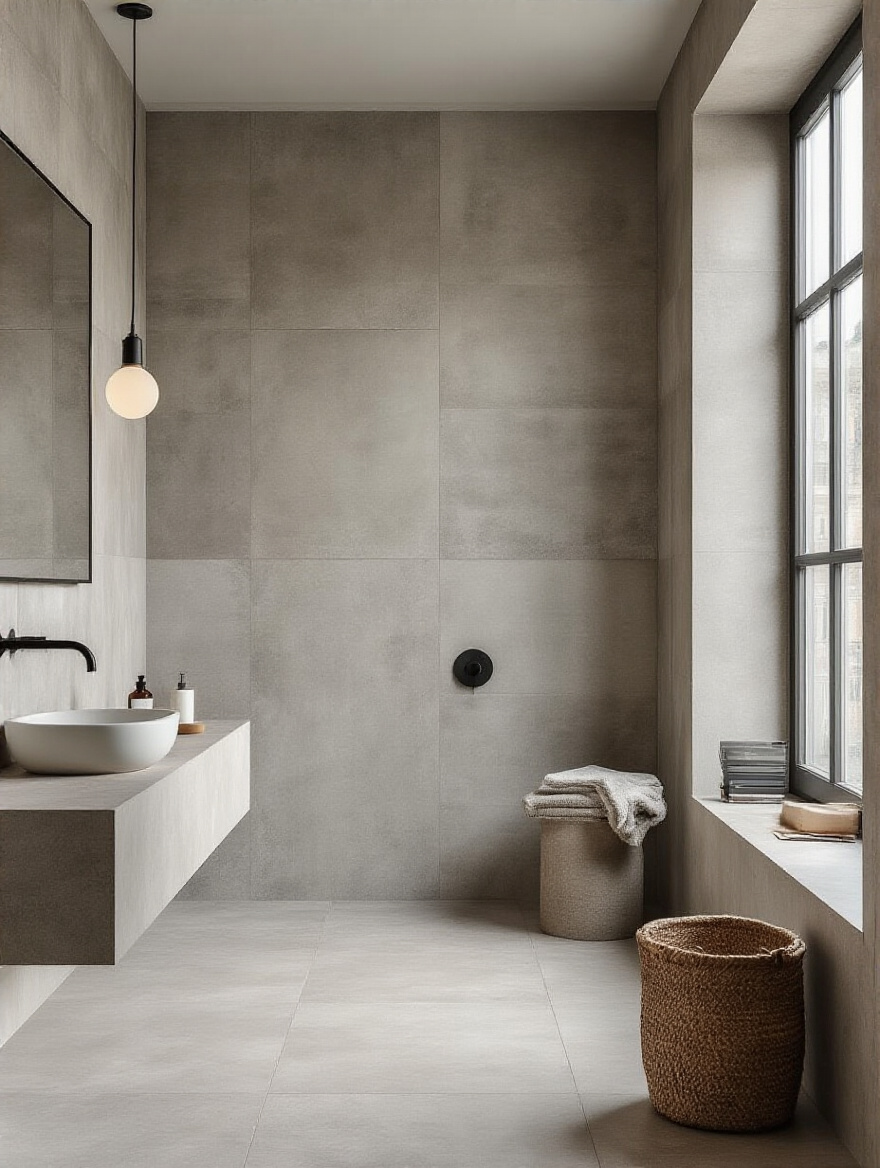
My advice is to work backward. Get quotes from a few highly recommended installers first. Once you know what the labor will cost, you can see what’s left for materials. And here’s a little shortcut: you don’t have to use the most expensive tile everywhere. Splurge on a beautiful tile for a feature wall or the floor, and then use a more affordable, simple tile—like a classic subway tile—in other areas. The high-low mix is the secret to a smart, stylish design.
And always, always have a contingency fund of at least 15%. I promise you, something unexpected will come up, whether it’s a leaky pipe behind the wall or realizing you need more tile than you thought. Having that buffer is the difference between a stressful project and one you can actually enjoy.
Once the budget is locked in, we can focus on the single element that will bring your tiles to life more than any other: the light.
Lighting isn’t just about being able to see where you’re putting your mascara. In a bathroom full of hard, industrial surfaces, lighting is what creates the mood. It’s what gives the space its soul. The wrong lighting—like a single, harsh overhead fixture—will make everything look flat and cold. But the right lighting can transform your tile into a work of art.
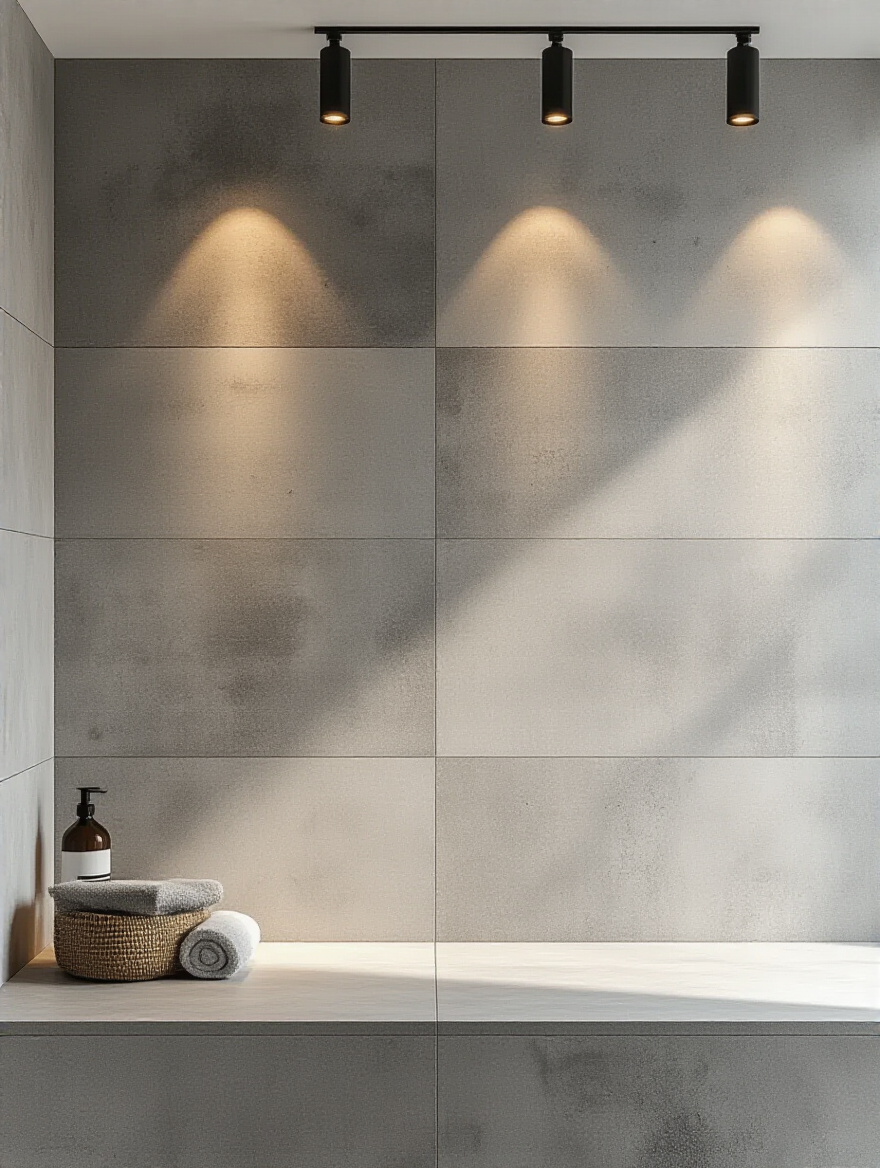
The secret is to think in layers. You need your practical “task” lighting by the mirror. You need soft, “ambient” light to fill the room with a general glow. But the magic is in the “accent” lighting. Think about a light that washes down a wall of textured tile, catching all the little imperfections and creating beautiful shadows. Or a small, waterproof light in a shower niche that makes your tile shimmer.
I always tell my clients to put everything on a dimmer. That way, you can have bright, clear light in the morning when you’re getting ready, and a soft, gentle glow at night when you’re taking a relaxing bath. Light is the paintbrush you use to finish the room, and it’s what will make your industrial space feel less like a factory and more like a sanctuary.
Alright, we’ve done our homework. Now for the fun part: choosing the actual tiles! This is where the story you started planning begins to take physical form. These materials are the vocabulary you’ll use to speak the language of industrial design.
Everyone loves the look of a real concrete floor, but let’s be practical. Real concrete is porous, it stains easily, and it needs to be sealed constantly, especially in a bathroom. It can be a real diva. This is where concrete-look porcelain comes in to save the day. The technology now is so good that you can get that beautiful, raw, monolithic look with all the durability and ease of porcelain.
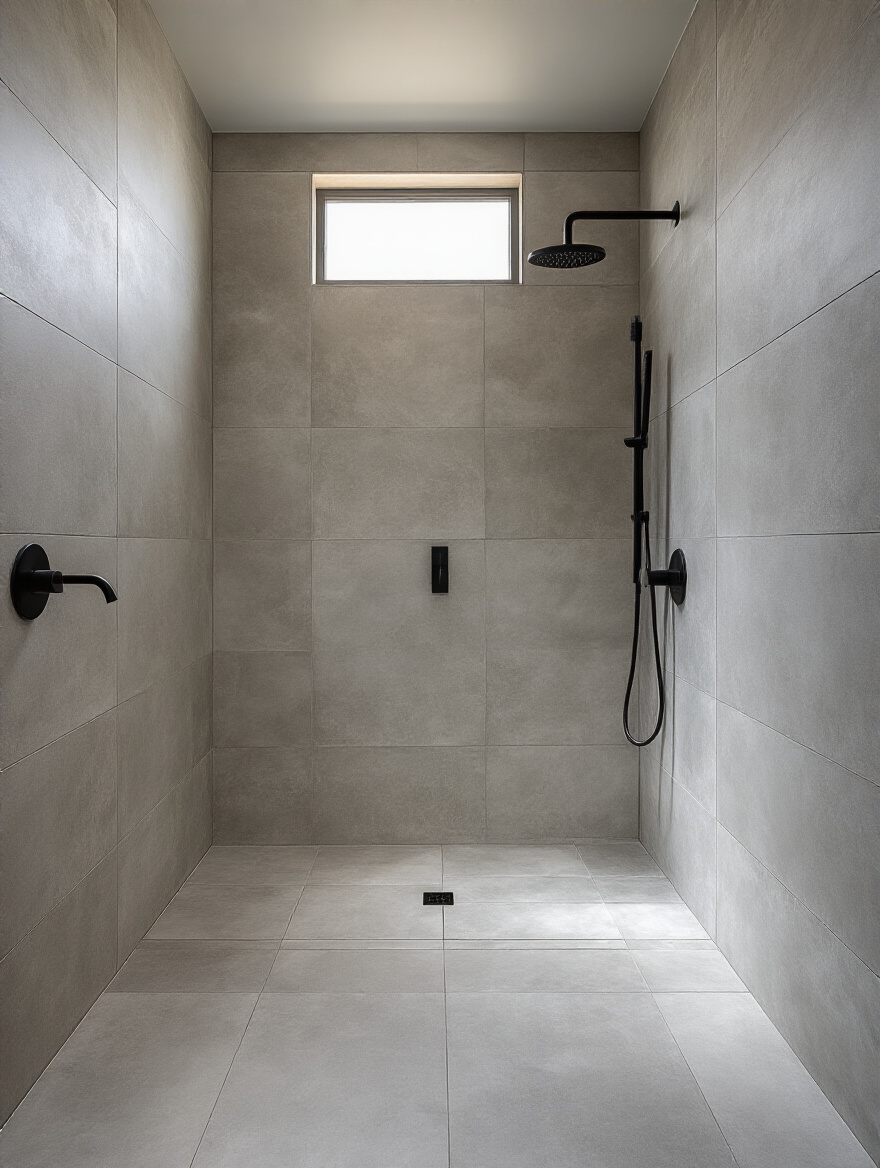
Look for large format tiles with a matte finish and rectified edges—that means the edges are perfectly straight, so you can have ultra-thin grout lines. This helps create that seamless, poured-in-place look. You can find them in a whole range of beautiful grey tones, from pale silver to deep charcoal, some with subtle variations and trowel marks that look incredibly authentic. It gives you all of the gritty, urban character without any of the maintenance headaches.
I once convinced a client who was set on poured concrete to go with porcelain instead. A year later, he called to thank me after his son spilled a bottle of red mouthwash on the floor. It wiped right up without a trace. Sometimes, the most authentic choice is the one that lets you actually live in your home without worry.
From the foundational concrete look, we can now explore its closest and most versatile cousin: the large format grey tile.
While concrete-look is a specific vibe, large format grey tile is its more versatile cousin. It’s the little black dress of industrial bathrooms. It’s timeless, sophisticated, and it provides the perfect neutral canvas for everything else you want to do in the space. Whether it has the texture of slate, stone, or just a subtle, uniform color, a large grey tile is always a chic choice.
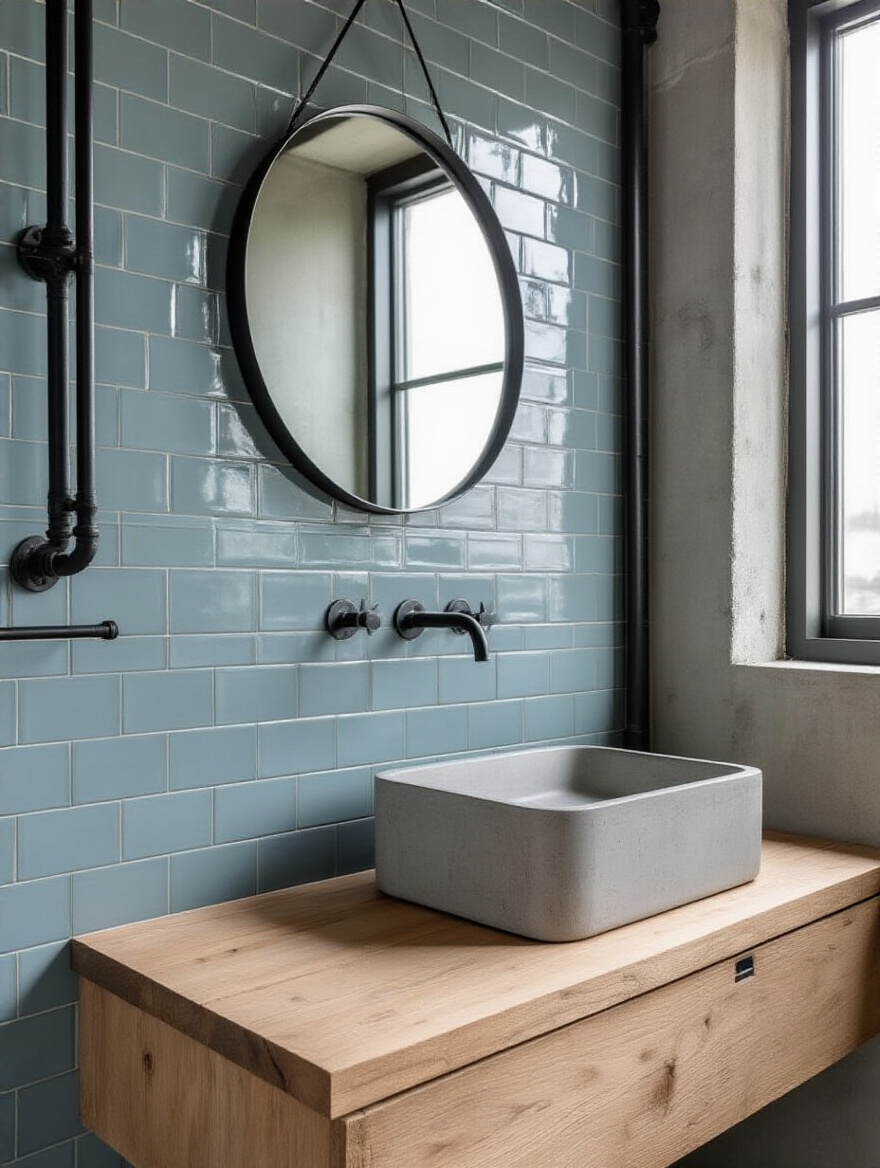
The real power here, again, is in minimizing those grout lines. A floor or wall covered in large grey tiles feels strong, calm, and uncluttered. It lets the architecture of the room speak. Your exposed pipes, your metal-framed mirror, your wooden vanity—they all become the stars of the show because the tile is doing its job as the perfect supporting actor.
Don’t be afraid to take it from the floor right up the walls of the shower. That continuity is what creates that high-end, custom-designed feel. It makes the whole room feel carved from a single block of stone—powerful, peaceful, and utterly chic.
If grey tile is the quiet, strong foundation, metal-effect tiles are the surprise element that adds a layer of history and character.
Now this is where things get really interesting. If you want to add a layer of history and texture that feels truly unique, you have to look at metal-effect tiles. I’m talking about porcelain tiles that look like aged Corten steel, oxidized copper, or weathered bronze. They have this incredible depth and variation of color that makes them look like they were salvaged from an old shipyard or factory.
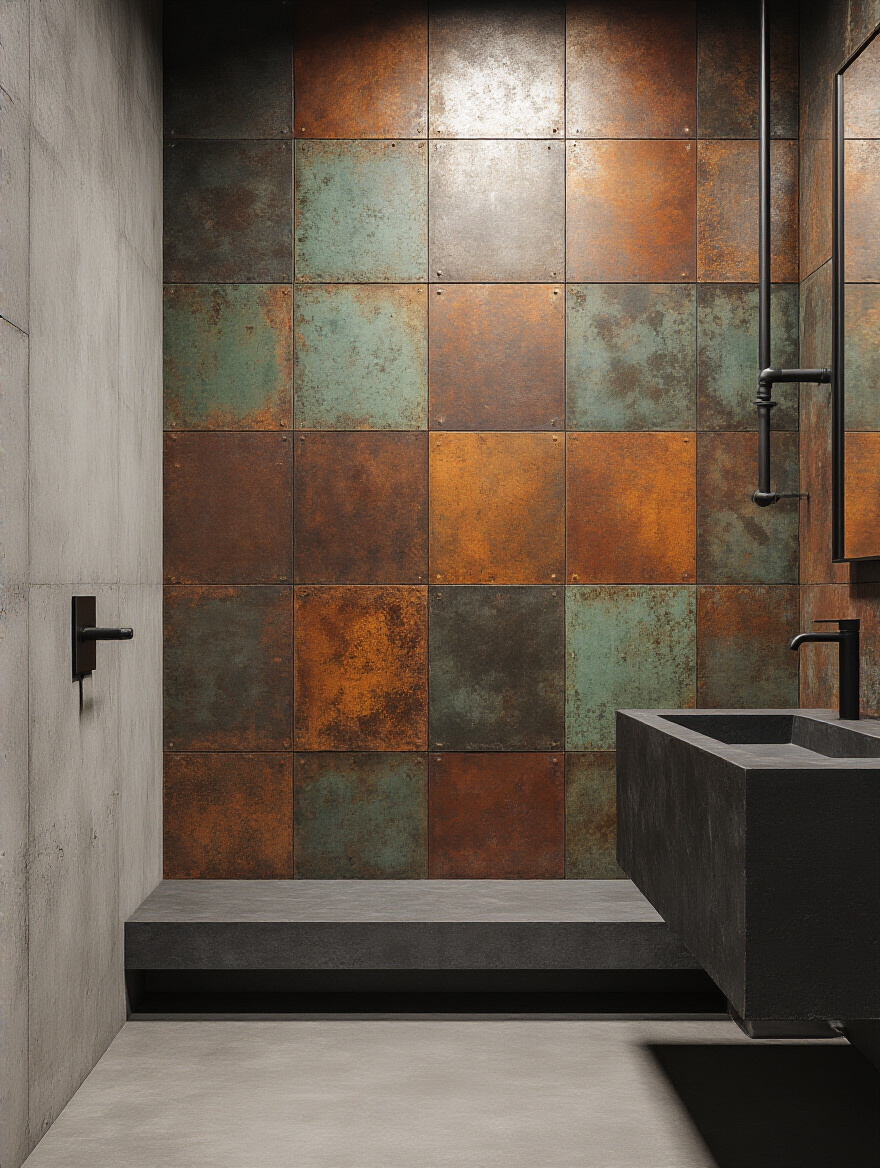
These are perfect for a feature wall—perhaps behind the vanity or inside the shower. A little goes a long way. You don’t want to tile the whole room in what looks like rusted metal, or it will feel too heavy. But one wall of it, next to a calm, concrete-look tile? Chef’s kiss. It’s the perfect way to add that gritty, found-object feeling without dealing with the hassle of sealing and protecting actual metal sheets.
It’s that tension between the old and the new, the rough and the smooth, that creates a truly dynamic design. A wall of rust-colored tile next to a sleek, modern sink is unexpected and unforgettable.
Of course, we can’t talk about tile without mentioning the hardworking, humble classic that can be transformed for this look: the subway tile.
I know what you’re thinking. “Subway tile? For an industrial bathroom?” But hear me out. Forget the glossy white subway tile with white grout that you see in every modern farmhouse. We’re taking this classic and giving it a gritty, urban makeover. Picture a subway tile in a muted, moody color—charcoal grey, dusty olive green, or even just a matte white. Now, pair it with a dark, dramatic grout, like black or deep charcoal.
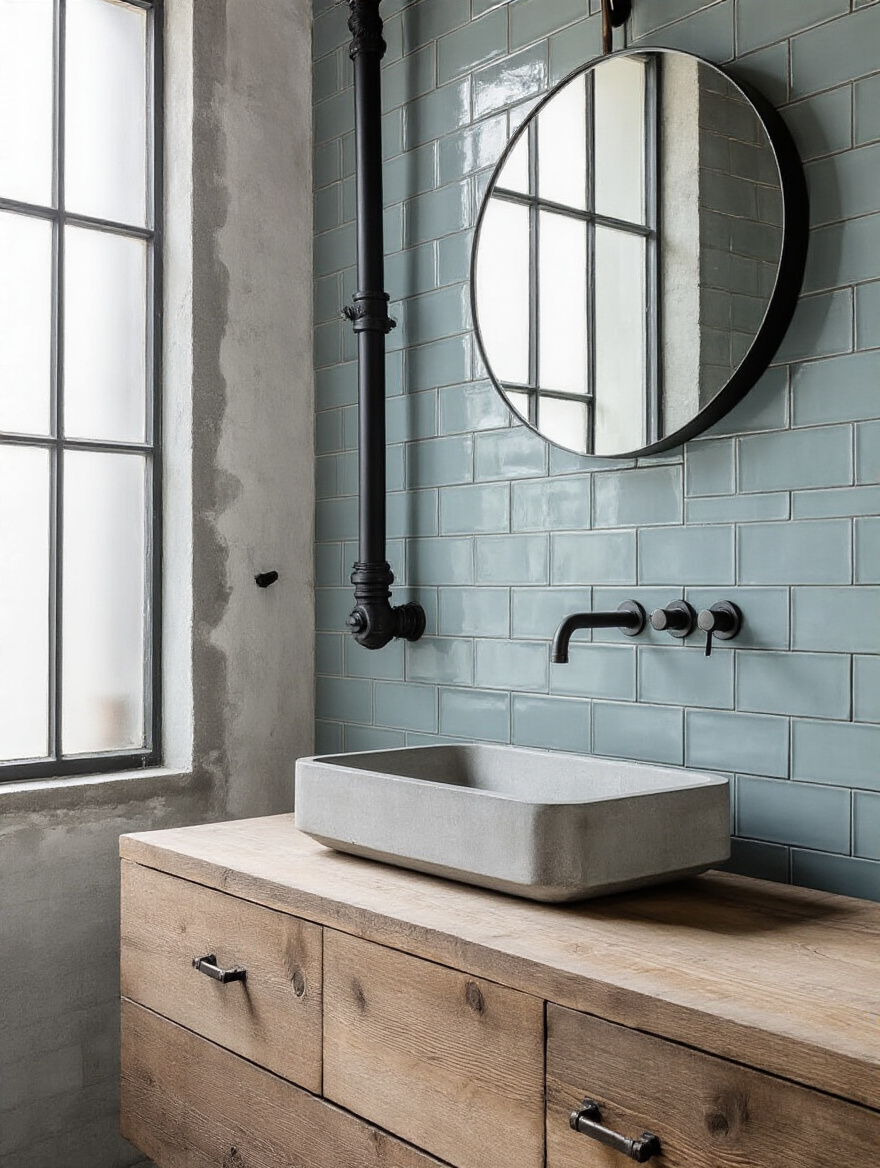
Suddenly, that simple tile is transformed. The dark grout outlines each tile, creating a strong, graphic grid that feels architectural and intentional. It calls to mind old warehouse windows or the tile work in a historic subway station. It’s a brilliant way to get a high-impact look for a relatively low cost. The contrast is what gives it its power and its undeniable industrial charm.
It’s proof that you don’t always need a fancy, expensive material to make a statement. Sometimes, it’s all about using a simple material in a smart, thoughtful way.
We’ve covered the classics. Now let’s look at some materials that add another layer of unexpected texture and warmth, pushing your industrial design into truly special territory.
Terrazzo is having such a wonderful comeback, and I am here for it. Traditionally, it was made with chips of marble and stone, but for an industrial look, think about terrazzo made with more rugged materials. Imagine a concrete base filled with flecks of recycled glass, chunks of contrasting concrete, or even metal shavings. It creates a floor that is incredibly durable and full of subtle, fascinating texture.
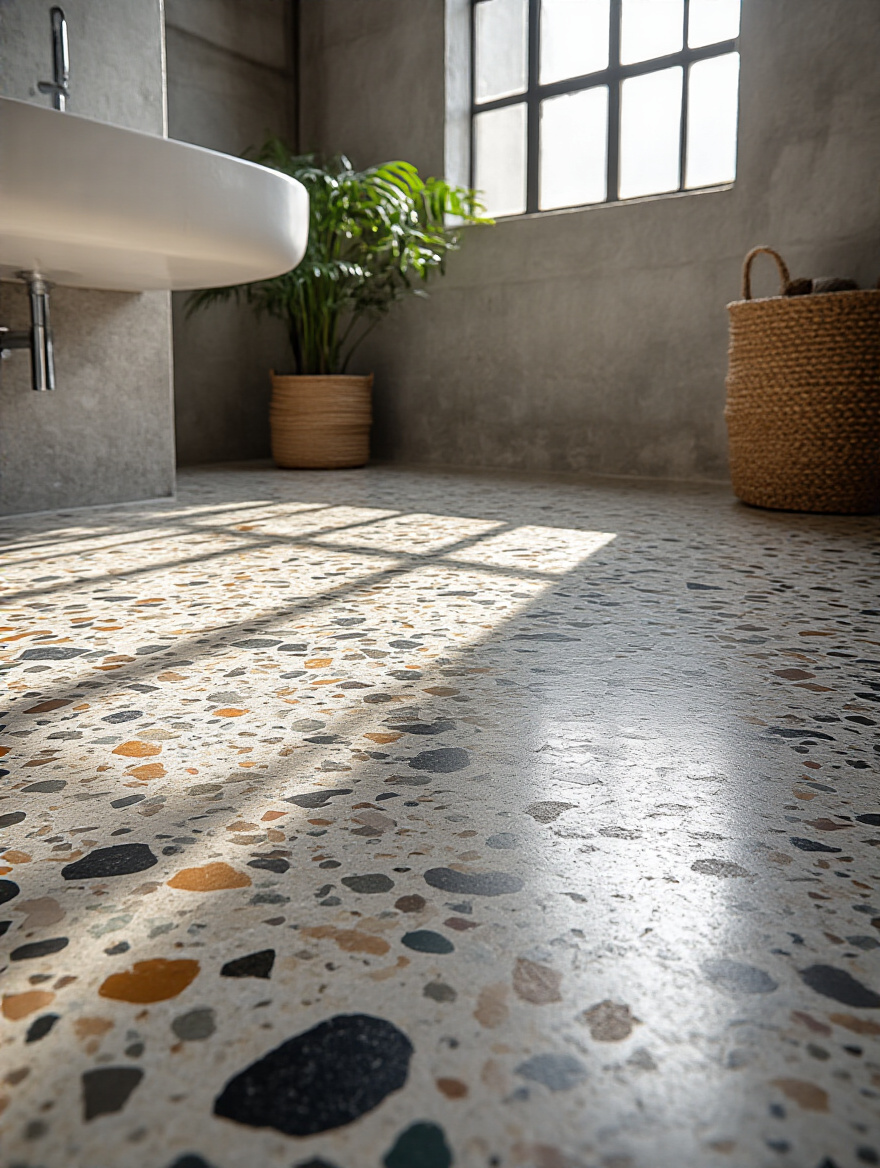
What I love about this is that it feels both nostalgic and modern at the same time. It has the soul of an old material you’d find in a beautiful building in Venice, but the raw aggregates give it a tough, urban edge. It’s the perfect blend of rustic and refined. Plus, it’s a wonderful way to incorporate recycled materials into your design, adding another layer to your bathroom’s story.
A terrazzo floor is a piece of art in its own right. It provides pattern and texture without being overwhelming, and it’s a fantastic way to tie together the different tones in your color palette.
While terrazzo brings cool, textural interest underfoot, our next choice is all about adding essential, organic warmth.
This might be the most important tile in the whole design. A purely industrial space can feel cold if you’re not careful. The secret weapon to prevent that is bringing in the warmth and texture of wood. But, of course, real wood in a wet bathroom is a terrible idea. Enter the magic of aged, distressed wood-look porcelain planks.
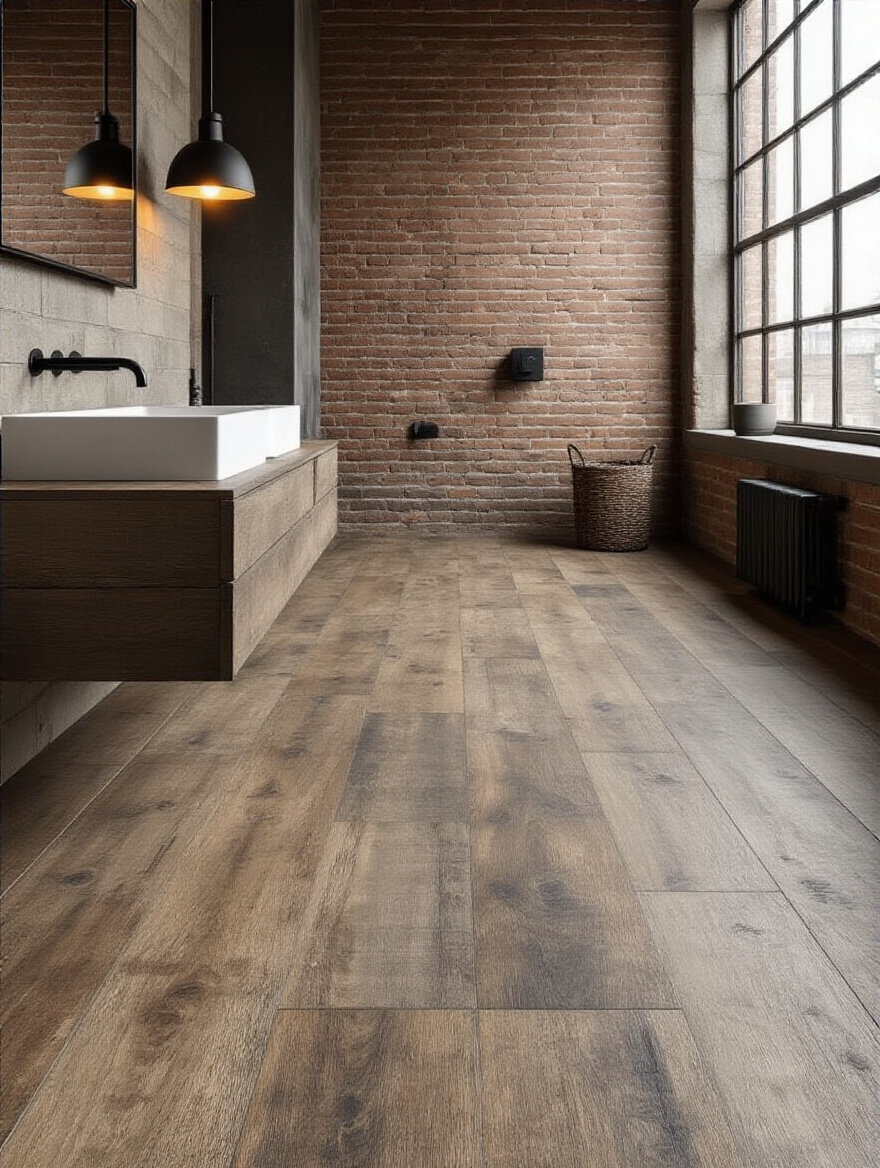
The quality of these tiles is astounding now. They have the grain, the saw marks, the knots, and the color variations of real reclaimed wood, but they’re completely waterproof and incredibly durable. Laying these on the floor can instantly balance the coolness of concrete walls or black fixtures. It’s that essential touch of nature that makes the space feel grounded and welcoming.
Look for planks with a matte finish and a bit of texture you can actually feel. It’s what makes them believable. I’ve used a warm, grey-washed wood-look tile in a bathroom with dark charcoal shower walls, and the combination was stunning. It was raw and strong, but also warm and inviting—the perfect industrial balance.
Now that you have your materials, we need to think about how to put them together. The pattern you choose for your tile is just as important as the tile itself. This is where you can add rhythm, direction, and another layer of personality to your design.
If you’re leaning toward a more modern, minimalist industrial look, the stack bond pattern is your go-to. This is where you lay rectangular tiles in a simple, straight grid—no staggering like a traditional brick pattern. The effect is clean, graphic, and very architectural. The strong vertical and horizontal lines emphasize the geometry of the room.
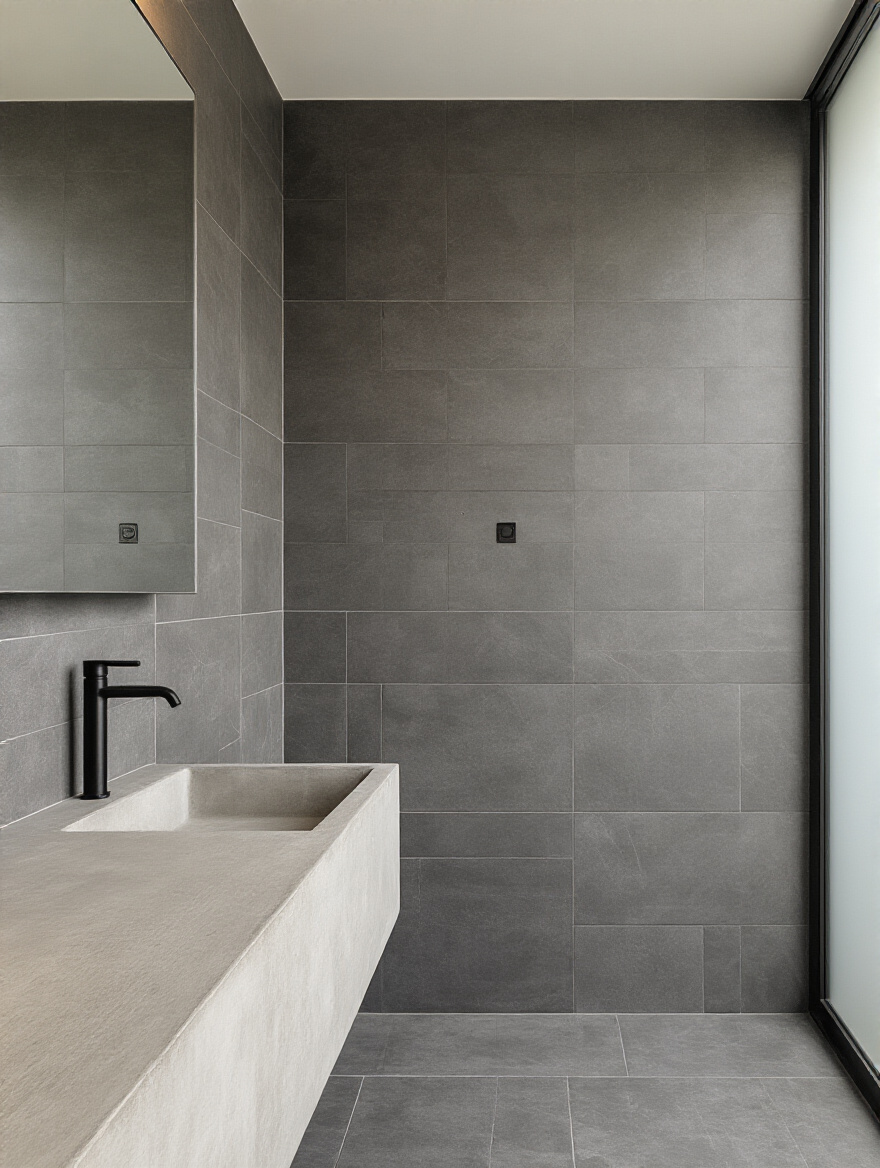
This pattern works beautifully with simple, solid-colored tiles. A wall of charcoal subway tiles laid in a stack bond looks incredibly chic and modern. It feels orderly and intentional, which aligns perfectly with the functional spirit of industrial design. It’s a quiet pattern that doesn’t scream for attention, allowing the texture of the tile and the other elements in the room to shine.
To make this look its absolute best, you must use rectified tiles and tiny grout lines. The precision is what makes it so powerful. It’s an elegant, understated choice that speaks volumes.
From the clean order of the stack bond, let’s explore patterns that introduce a sense of dynamic movement and classic artistry.
If the stack bond is too quiet for you, a herringbone pattern is how you turn up the volume. Laying rectangular tiles in this classic V-shape creates a sense of movement and energy that is absolutely captivating. I adore using a dark tile—like a black slate-look or a deep espresso wood-look tile—in a herringbone pattern on the floor.
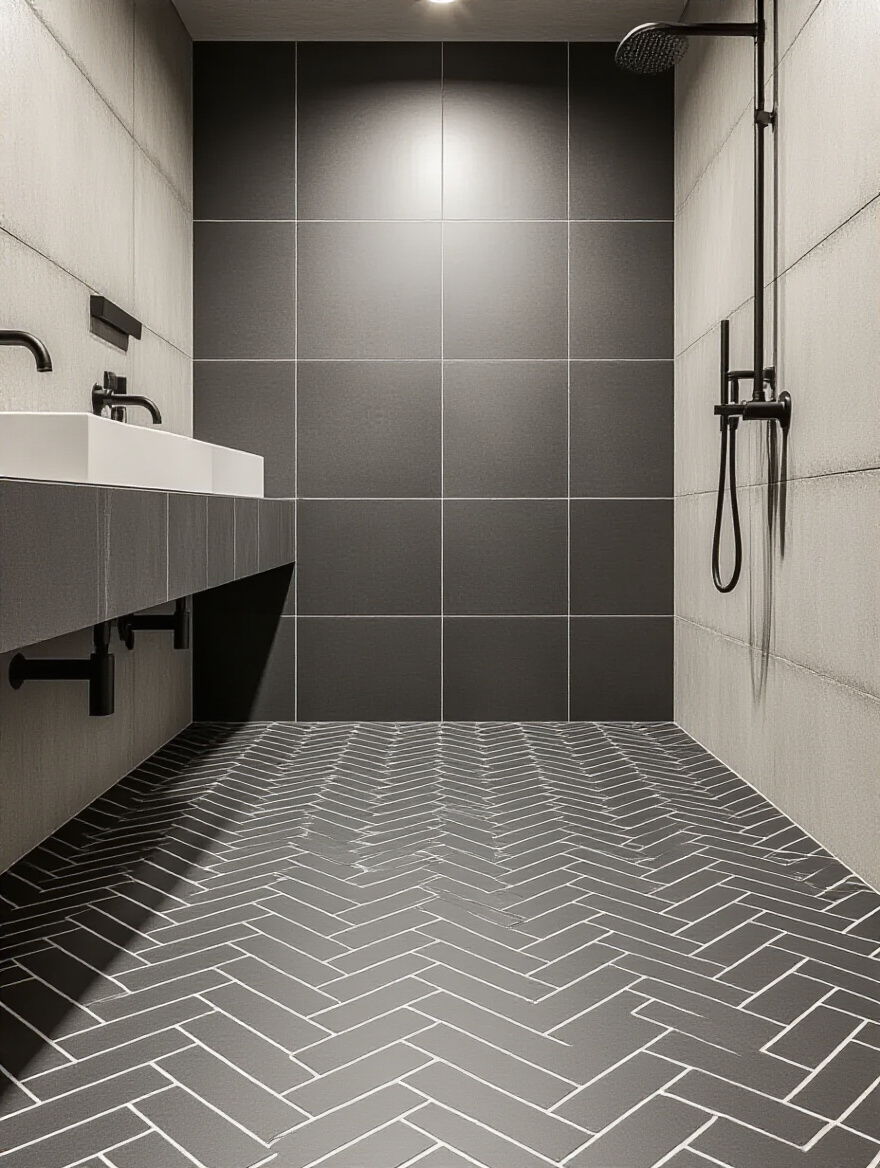
It feels both classic and edgy at the same time. The pattern has a historical feel, like the old parquet floors in a Parisian apartment, but using it with a dark, industrial-style tile gives it a completely modern twist. It adds a layer of sophistication and visual texture that can make an entire room. It can be your one big “wow” moment in an otherwise simple space.
A basketweave pattern, which creates a series of small squares, offers a similar level of detail but with a slightly more geometric, contained feel. Both are fantastic ways to make a floor or a feature wall feel special and custom-designed.
Beyond patterns, a powerful way to define and elevate the space is by using tile to create distinct functional zones.
A wonderful trick to make a bathroom feel more dynamic and thoughtfully designed is to use a different tile inside the shower. This visually separates the wet zone from the rest of the room and creates a beautiful focal point. It’s like creating a room within a room.
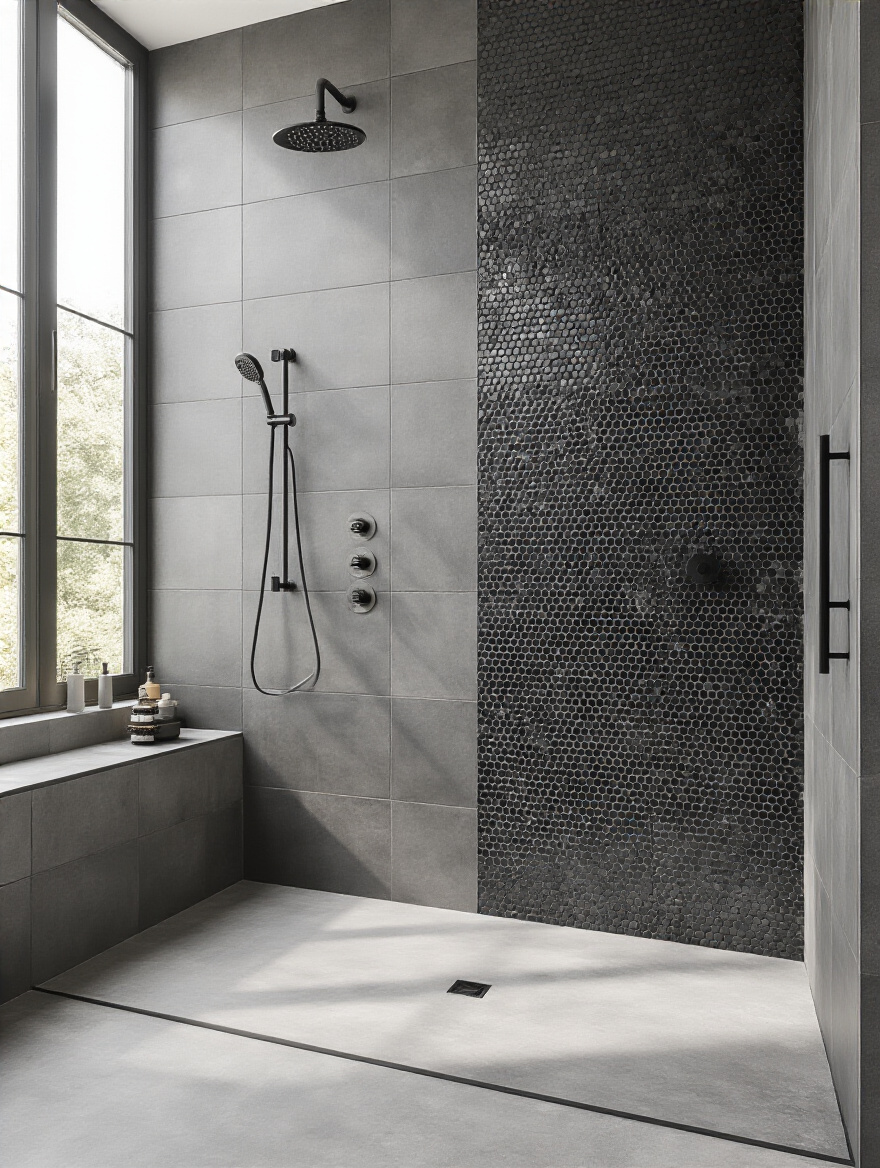
The key is to choose a tile that contrasts in either texture, shape, or shade. For example, if your main floor and walls are large format concrete-look tiles, you could use a small, matte black hexagon mosaic on the shower floor and in the niche. The change in scale and color creates immediate interest and depth. Or, you could pair smooth grey tiles in the main bathroom with a textured, metallic-look tile on one wall of the shower.
This is also a great place to use a more expensive or daring tile that you might not want to commit to for the whole room. It’s a contained moment of drama that adds a huge amount of personality and custom flair to the design.
Now, let’s talk about pairing your beautiful new tile with the ultimate industrial material for a truly authentic feel.
If you are lucky enough to have an exposed brick wall in your bathroom, you have won the industrial design lottery. There is simply nothing that says “authentic loft” more than raw, aged brick. The key is to choose a tile that complements it, rather than competes with it.
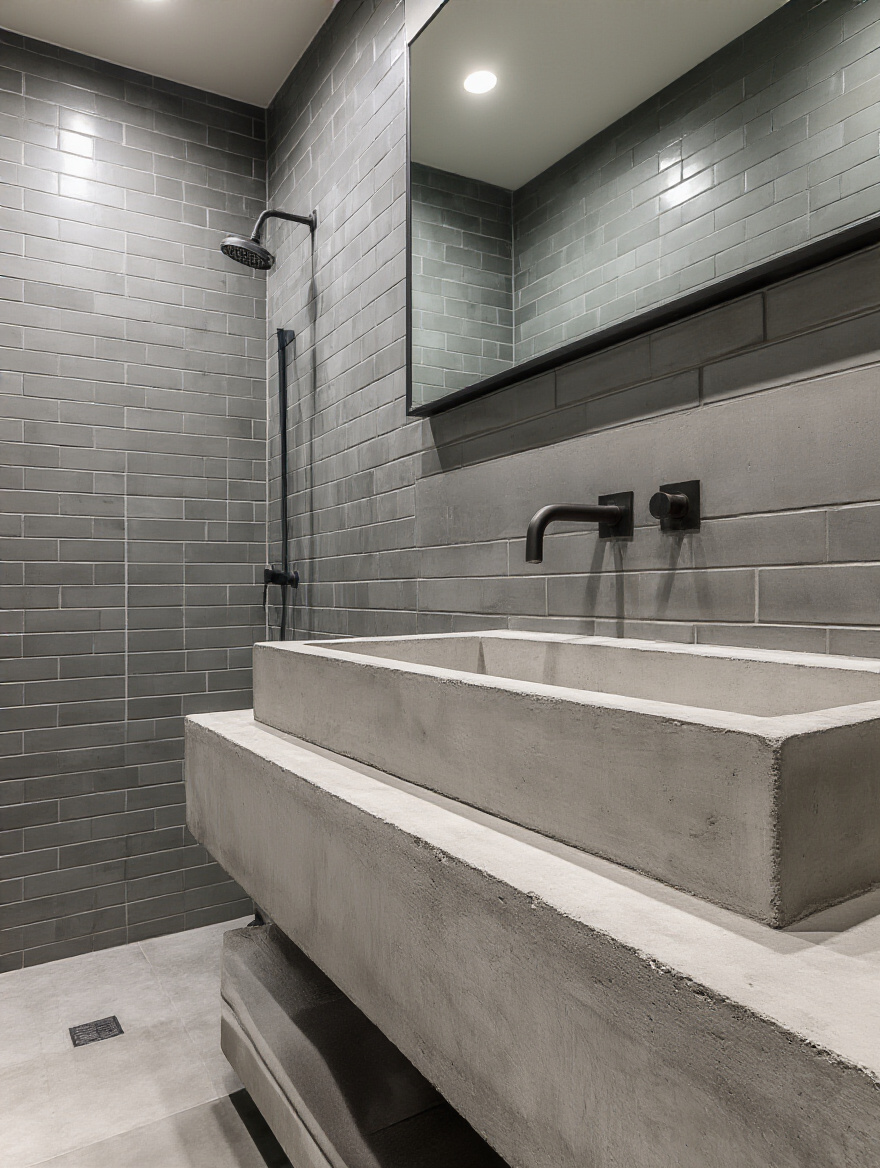
You want to let the brick be the star. Simple, large format tiles in a neutral color like grey or black work beautifully. A concrete-look porcelain floor next to a brick wall is a classic, unbeatable combination. The smooth, cool finish of the tile provides the perfect contrast to the warm, rough texture of the brick. You can also pair it with a simple white subway tile with dark grout for a look that feels clean yet rustic.
The one thing you absolutely must do is properly seal the brick. Bathrooms are wet, and brick is porous. A high-quality matte sealer will protect it from moisture and mold without changing its beautiful, raw appearance. It’s the essential step to making this iconic look last.
We’re diving deeper into the artistry of tile here. These next two ideas are about creating powerful visual statements that can define the entire character of your bathroom.
If you want to create a bathroom that feels incredibly spacious, serene, and high-end, this is the technique for you. Taking the exact same tile you used on the floor and running it straight up the walls of the shower creates a seamless, monolithic look. It blurs the lines of where the floor ends and the wall begins, making the entire space feel like one cohesive, expansive unit.
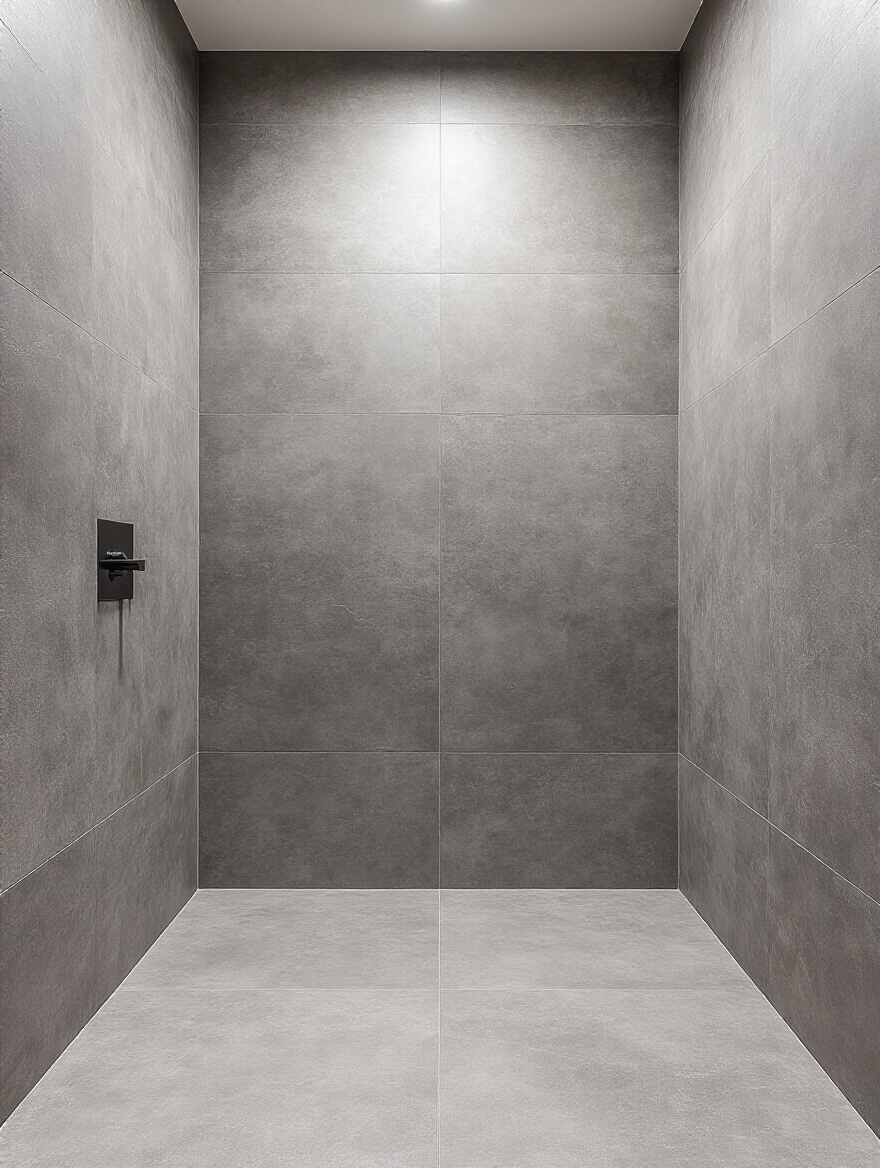
This works best with large format tiles, like a concrete or stone-look porcelain. With minimal grout lines, it can almost look like the entire room was carved out of a single piece of material. It’s a very bold, minimalist statement that is perfect for a modern industrial aesthetic. Paired with a frameless glass shower door, it creates the ultimate open, airy wet room feel.
A word of warning: this requires an absolutely meticulous installer. The grout lines from the floor have to align perfectly with the grout lines on the wall. When done right, it’s pure architectural magic.
From the subtle power of continuity, we now swing to the bold and artistic expression of a feature wall.
While much of industrial design is about restraint, sometimes a space just calls for a moment of joyful, unapologetic pattern. Creating a feature wall with graphic cement tiles is the perfect way to inject art and personality into an otherwise utilitarian space. Think of it as hanging a giant painting, but one that’s waterproof and durable.
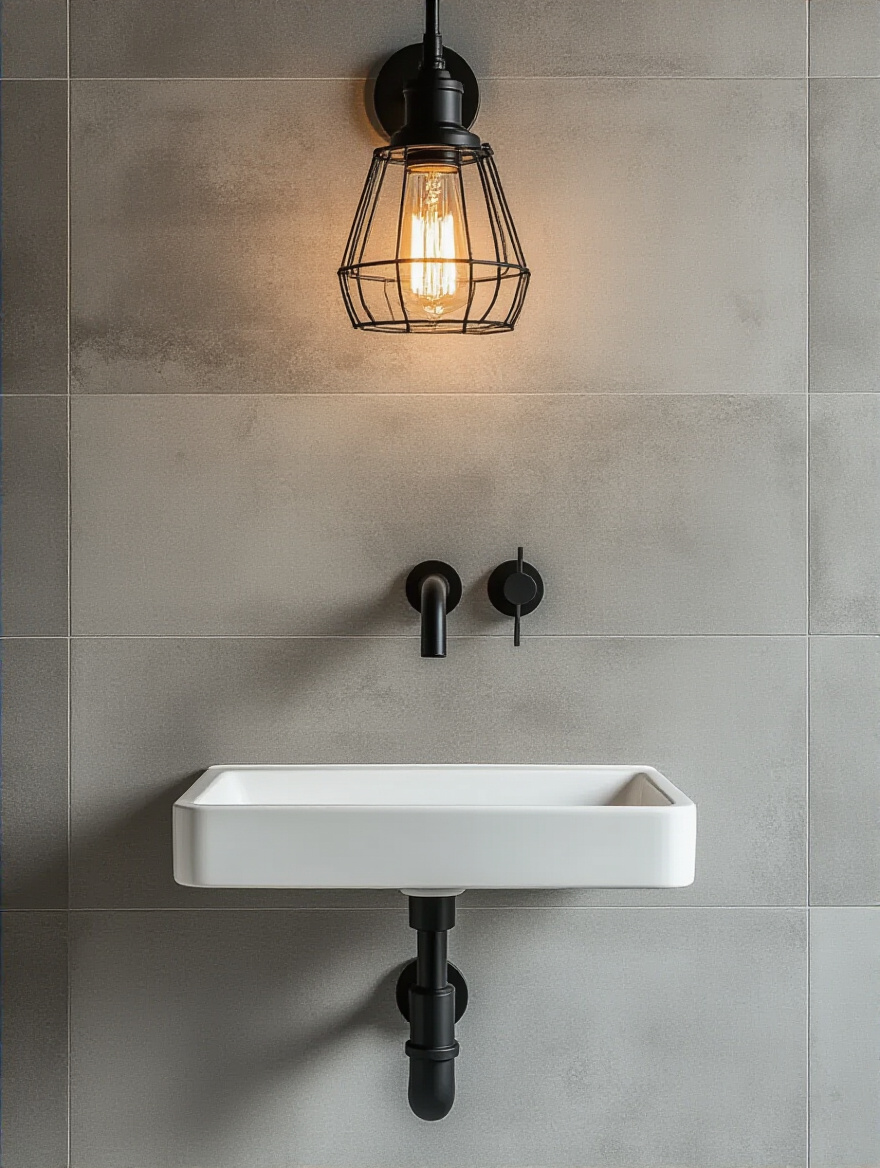
I love pairing a bold, black and white geometric cement tile with simple concrete-look tiles. The cement tile becomes the undeniable focal point—perhaps on the wall behind the vanity or the back wall of the shower. It provides a beautiful, artisanal contrast to the raw, machine-age feel of the other materials. It’s a nod to history and craftsmanship, which feels right at home in an industrial space.
Just remember to keep everything else relatively simple. One bold statement is powerful. Five bold statements is chaos. Let the feature wall sing, and have everything else be the quiet, beautiful backup singers.
The tile is the foundation, but the finishing touches are what bring the entire vision to life. This is the jewelry of the room—the elements that add sparkle, contrast, and complete the story.
Exposed plumbing isn’t something to hide; it’s something to celebrate! In an industrial bathroom, pipes are sculpture. The key is to choose finishes for your pipes, faucets, and light fixtures that create a beautiful dialogue with your tile. For example, matte black fixtures look stunning against a pale grey concrete tile, creating a sharp, graphic contrast.
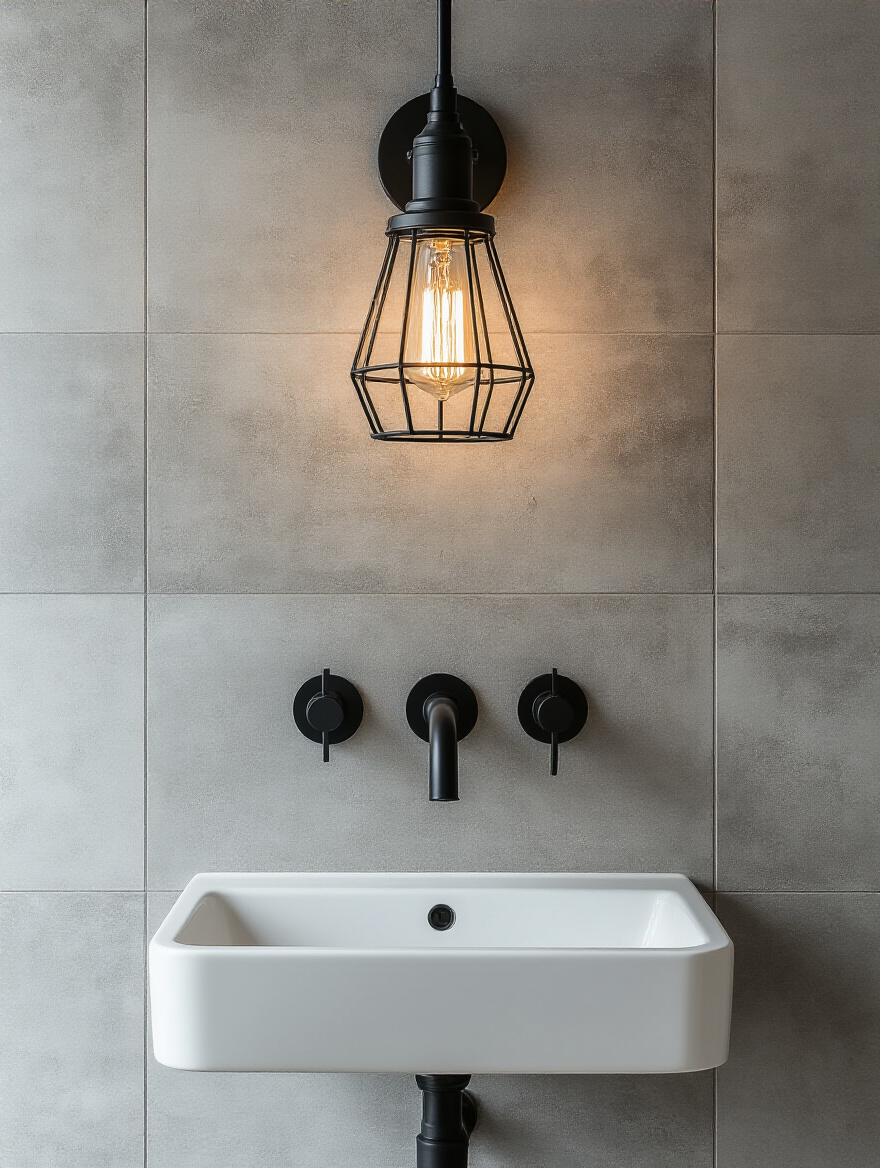
But my favorite combination is pairing warm metals with cool tiles. Think about aged brass or copper faucets against a dark charcoal or white subway tile. The warmth of the metal is the perfect antidote to the coolness of the tile. It feels rich, and classic, and it adds a layer of unexpected glamour to a raw space.
The same goes for your lighting. A caged sconce with an Edison bulb or a simple metal dome pendant will reinforce the aesthetic. Coordinate your metal finishes across the plumbing and lighting to create a cohesive, intentional look that feels pulled-together and professional.
Moving from the metal accents that adorn the walls, let’s consider a feature that grounds the space with raw, material honesty.
If you truly want to commit to the industrial aesthetic, a concrete countertop or an integrated sink is an incredible statement piece. It’s raw, it’s honest, and it has a beautiful, weighty presence that can anchor the entire room. A thick, cast concrete vanity top provides a wonderful textural contrast to almost any tile.
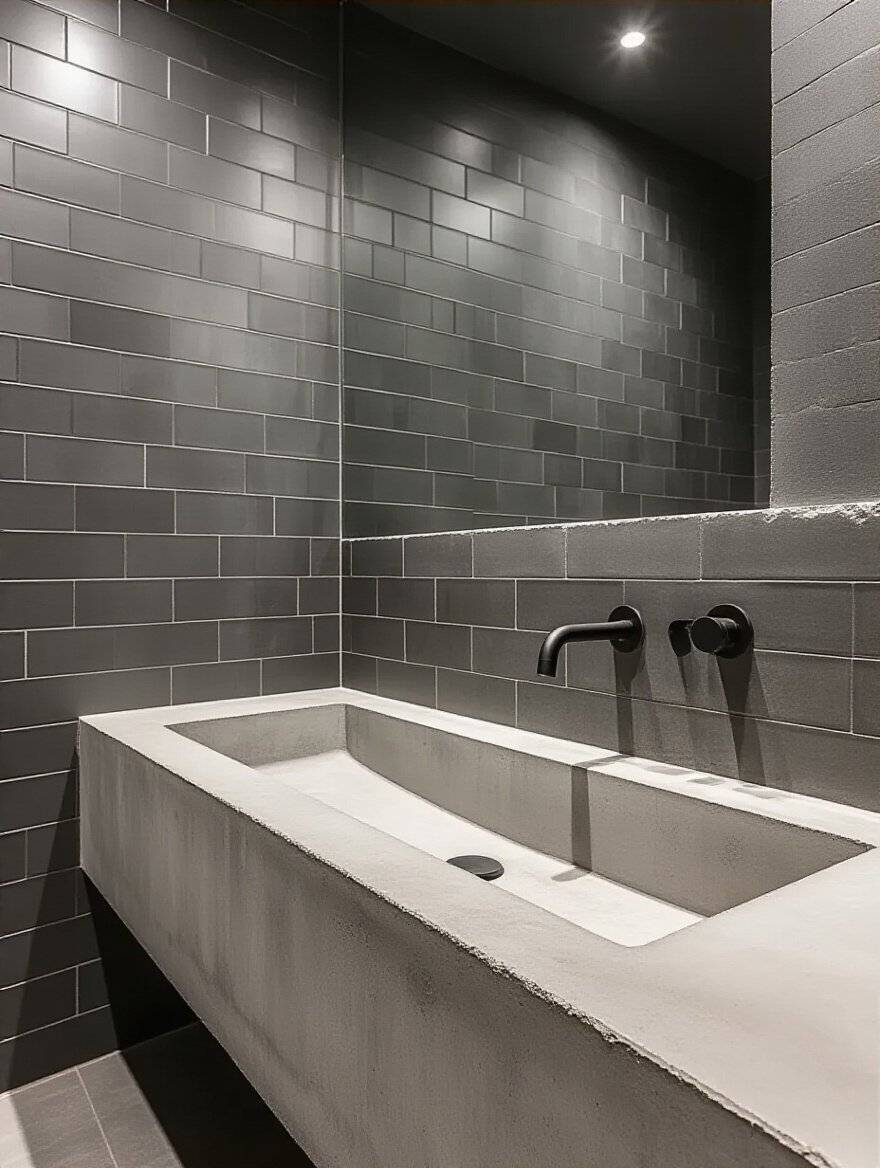
You can have it polished smooth for a more modern look, or left more raw and textured for a rustic feel. Paired with a simple wood vanity base and set against a tiled wall, it is the epitome of industrial chic. What I love is that each concrete piece is unique, with its own subtle variations and imperfections. It’s a material with character.
Just like with a brick wall, sealing is non-negotiable here. Concrete is porous, so a high-quality, food-safe (for countertops) sealer is essential to protect it from water, soap, and cosmetic stains. It’s a bit of work, but the payoff is a truly unique, sculptural element in your bathroom.
Now, let’s talk about the small detail that makes a massive difference: the color of your grout.
Grout is the unsung hero of tile work. Most people think of it as just the stuff that goes between the tiles, but it is a powerful design tool. For an industrial look, nine times out of ten, you should be choosing a dark grout. A charcoal, deep grey, or black grout is what gives your tile work that gritty, defined, and authentic edge.
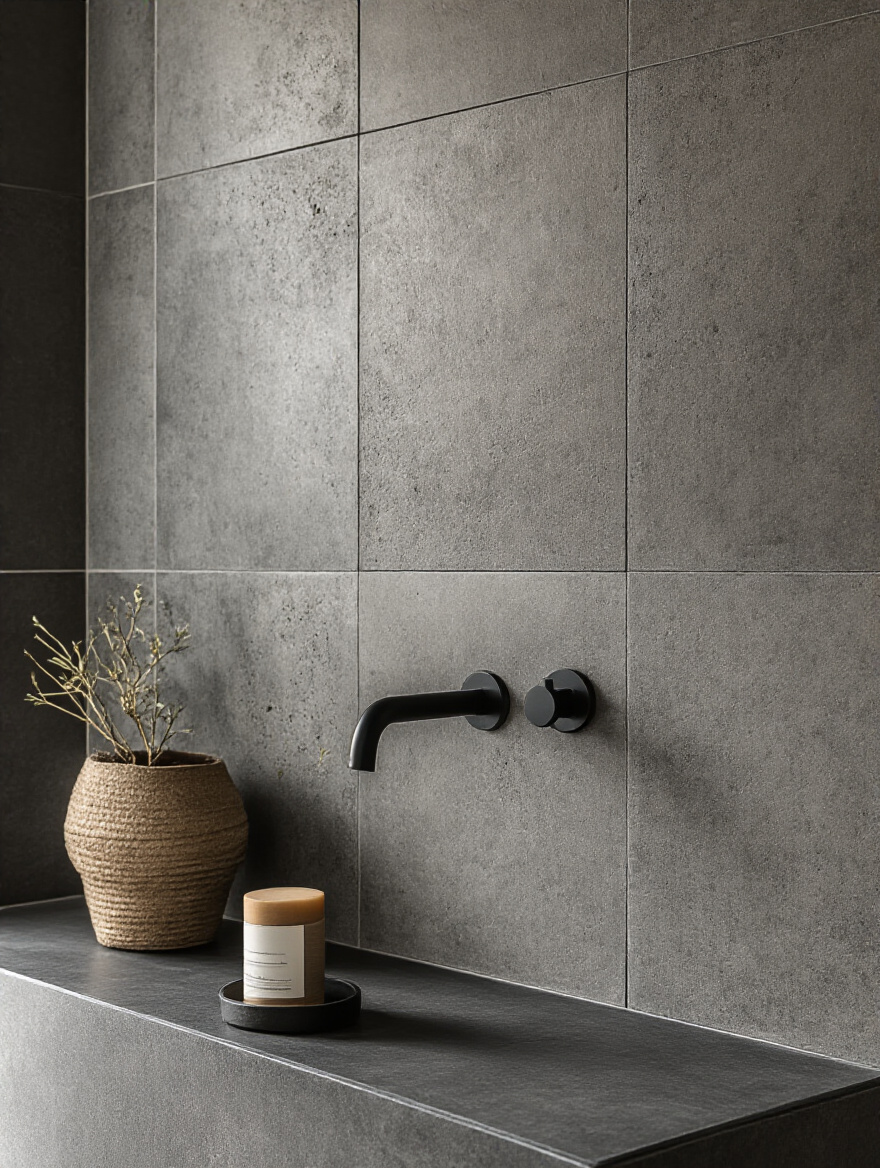
Think back to the subway tile idea. It was the dark grout that transformed it from sweet to tough. The same is true for almost any tile. A dark grout creates a strong grid that emphasizes the shape of each tile and adds a graphic quality to the entire surface. It feels more utilitarian and less decorative, which is exactly the vibe we’re going for.
And here’s a practical bonus: dark grout is a lifesaver when it comes to cleaning. It’s so much more forgiving than light grout, which can show every speck of dirt and mildew. In a bathroom, that’s a gift from the design gods.
Finally, let’s complete the look with those small but mighty pieces of hardware that tell a story of a life before this one.
This is the final layer of soul. After all the big pieces are in place, it’s the small details that make a space feel truly special and personal. Scouring flea markets or architectural salvage yards for old hardware is one of my favorite parts of the design process. An old cast iron towel bar, reclaimed steel shelf brackets, or vintage iron cabinet pulls can add a sense of history that you simply cannot buy new.
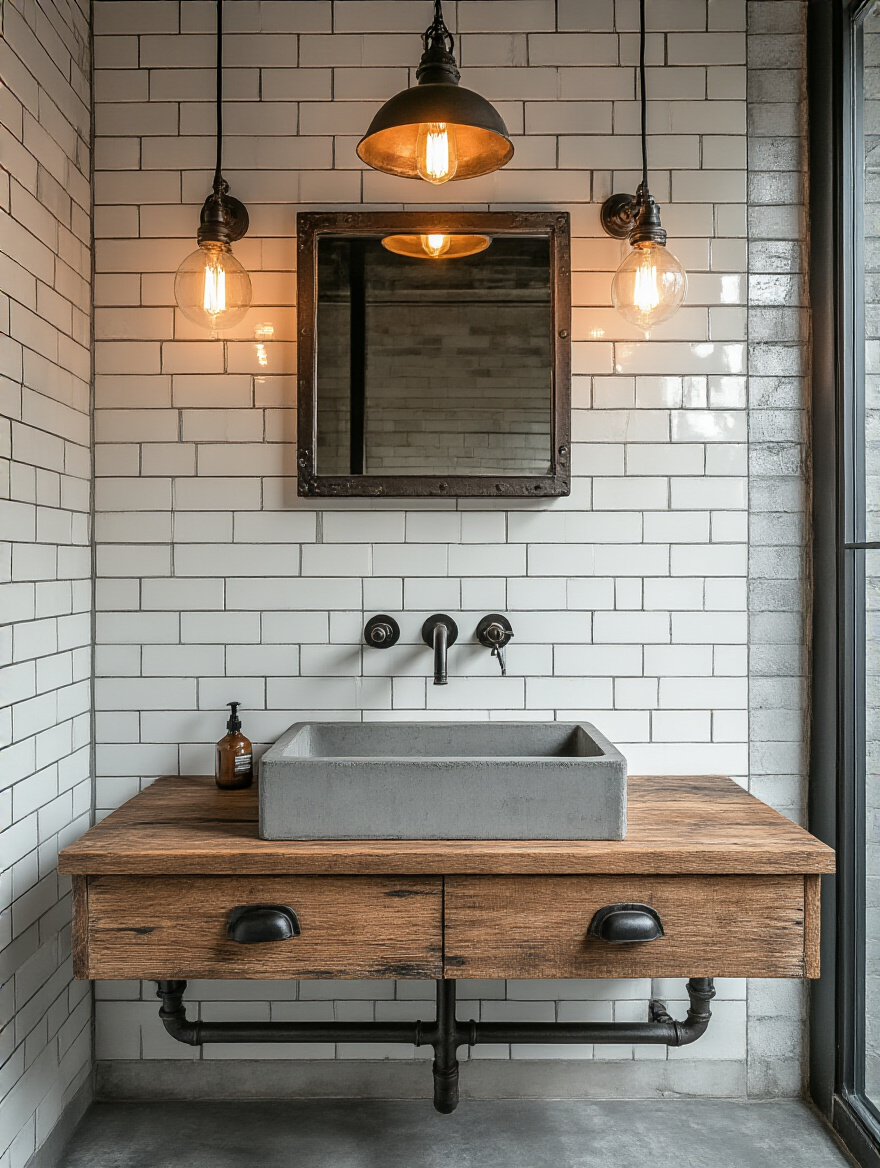
These pieces have a patina and a story. They’ve been touched by hands, they’ve been worn by time, and they bring that authentic, lived-in energy to your brand-new bathroom. It’s that perfect little imperfection that keeps the design from feeling too sterile or staged.
Don’t be afraid to mix and match. The goal isn’t to have everything look perfect; it’s to have it look collected and curated over time. That is the true heart of both industrial and Mediterranean design—creating spaces that feel like they have a rich, interesting past.
You’ve created something beautiful! Now, let’s make sure it stays that way. A well-designed space is one that not only looks good on day one, but continues to look good for years to come. This is the final, crucial piece of the puzzle.
I know, cleaning is boring, but a little bit of care will protect the beautiful investment you’ve made. The good news is that most industrial-style tiles, especially porcelain, are incredibly low-maintenance. The number one rule is to avoid harsh, acidic cleaners. They can damage the surface of the tile and eat away at your grout over time. A simple, pH-neutral cleaner is all you need for regular upkeep.
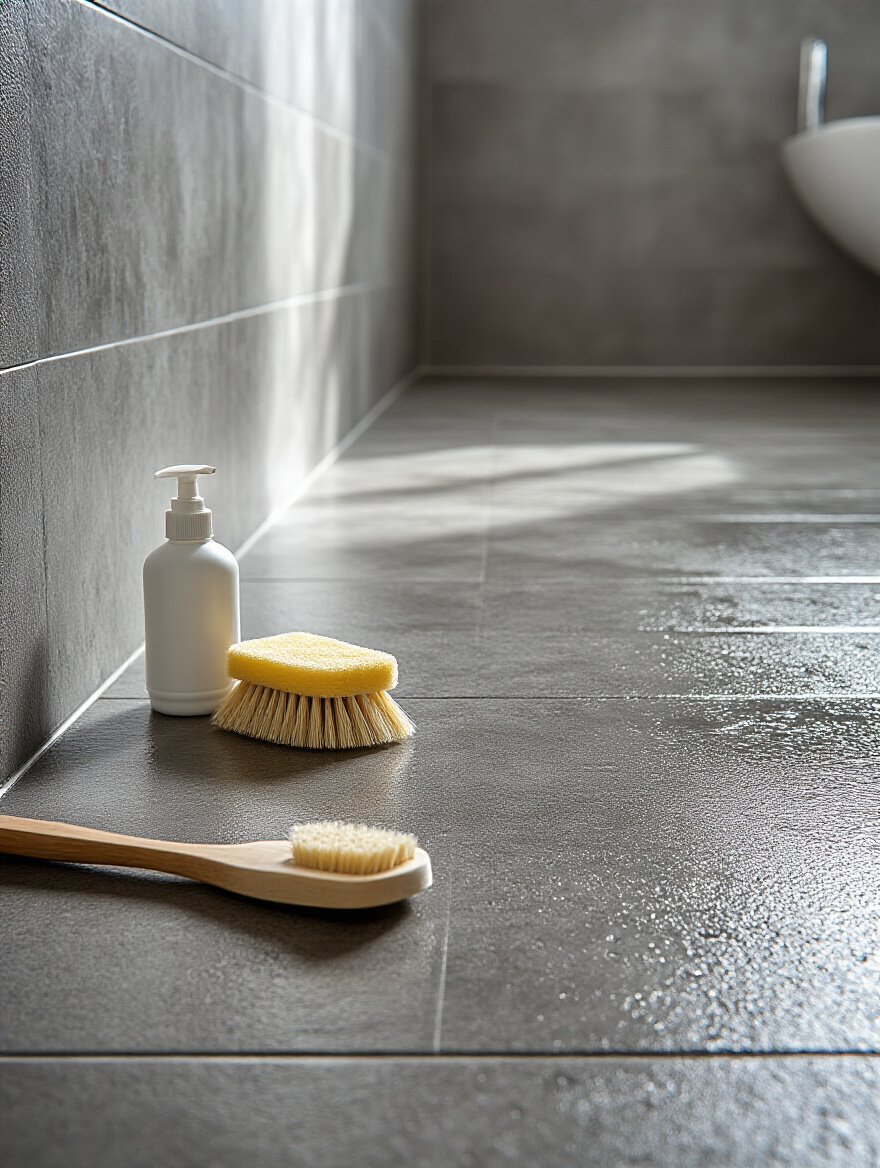
For grout, especially in the shower, keeping a small squeegee or a microfiber cloth handy to wipe down the walls after you shower makes a huge difference. It prevents soap scum from building up and keeps mildew at bay. And about once a year, it’s a good idea to check your sealant on any porous surfaces like brick, concrete, or cement tile. Just sprinkle a little water on it—if it beads up, you’re good. If it soaks in, it’s time for a fresh coat.
Think of it not as a chore, but as an act of love for your home. You’ve put so much thought and care into creating this space, and these simple rituals will ensure it stays just as beautiful as the day it was finished.
So, you see? Industrial design doesn’t have to be cold. It doesn’t have to feel like a factory. When you approach it with warmth and a love for honest materials, it can be one of the most soulful, character-rich styles there is. It’s about finding the beauty in strength, texture, and imperfection. It’s about creating a backdrop for your life that is strong, authentic, and unapologetically you.
The tiles we’ve talked about are your building blocks, but your vision is the mortar that holds them all together. Don’t be afraid to mix the rough with the smooth, the dark with the light, and the old with the new. Trust your instincts. Create a space that feels like a sanctuary—a place where you can wash away the day and feel completely at home. Now go, take these ideas, and build something wonderful. I can’t wait to see it.